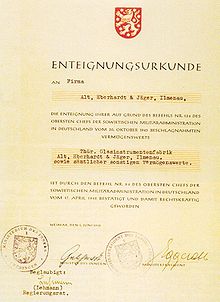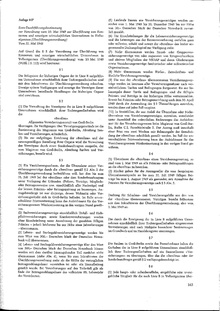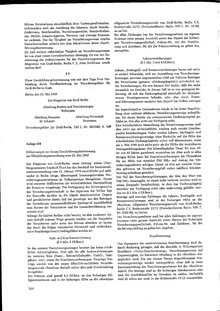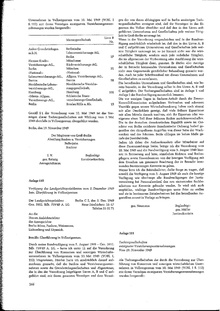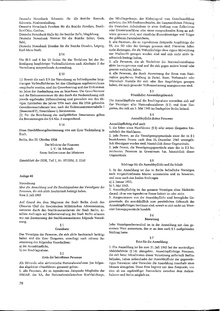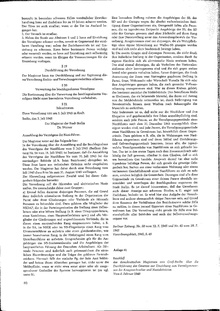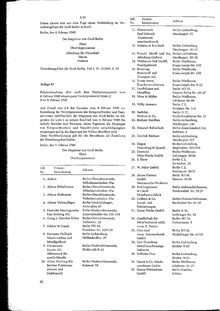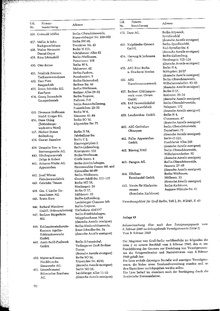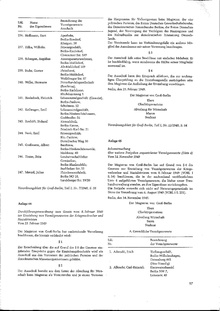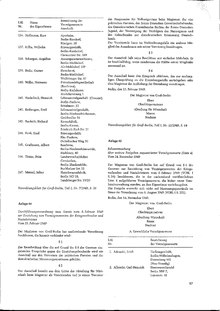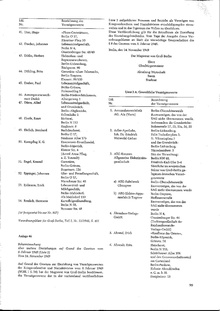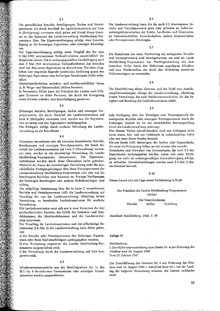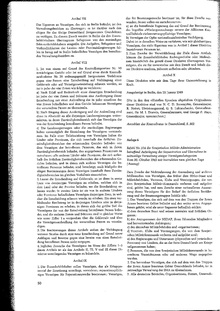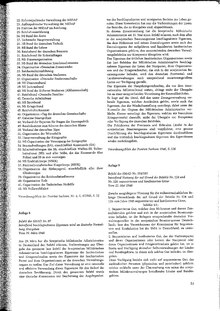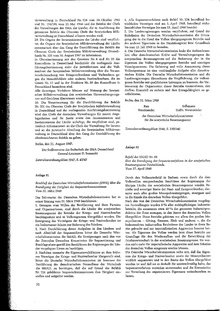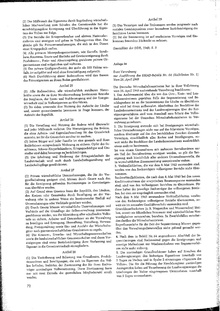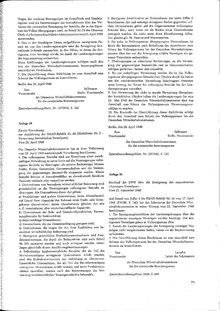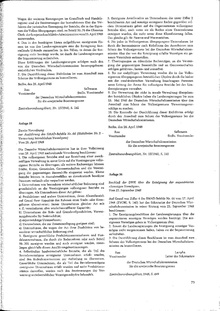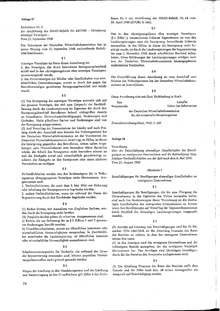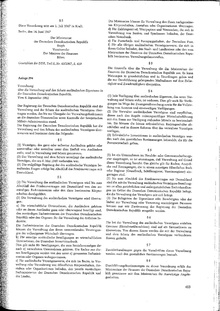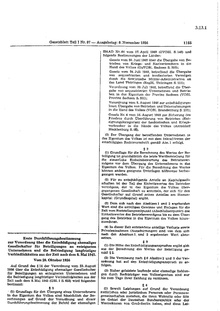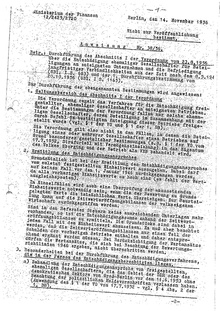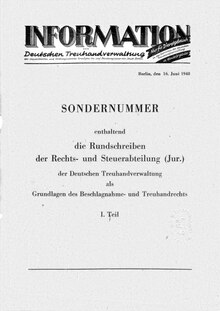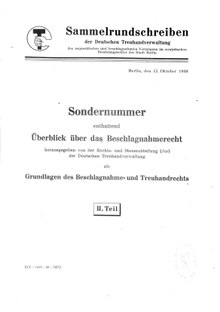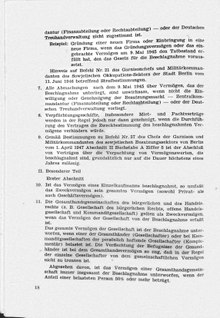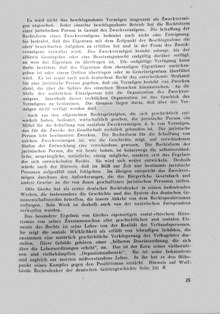Industrial reform in the Soviet zone
The industrial reform is closely linked to the land reform in the Soviet occupation zone (SBZ) and the forced collectivizations in the GDR . It describes the expropriation of around 10,000 industrial companies without compensation . These state-owned enterprises formed the industrial basis for a new economic order based on the model of the Soviet planned economy. The basis for the industrial reform / list expropriation in the Soviet Zone was the interpretation of the Potsdam Protocol of August 2, 1945 and the Control Council legislation between 1945 and 1948. The appeal of the KPD Central Committee of June 11, 1945, which was initiated by Stalin , was in advance determined that there will be extensive expropriations based on the Soviet model. The Potsdam Agreement stipulated, among other things, that war criminals should be punished and that existing economic concentrations (monopoly associations, cartels) should be eliminated. The implementation took place in the Control Council Act No. 10 of December 20, 1945. The law provided for the punishment of war criminals, their organizations and their assistants. In the third section, it laid down the scope of punishment (partial loss of civil rights , deprivation of property, imprisonment, forced labor and the Condemnation to death). With the Control Council Directive No. 38 of October 12, 1946, the guidelines in occupied Germany were to be standardized and the measures to be further specified. In this law, the accused were divided into five main groups (main accused, accused, minor accused, followers, exonerated). Main accused lost and a. All of their assets, those who were encumbered lost some or all of their assets, those who were less encumbered lost some of their assets, etc. Directive No. 57 of January 15, 1948 stipulated what should be done with the confiscated assets. This included the transfer back to the owners before the Nazi era. If a return transfer was no longer possible or was refused, the assets should be transferred to the federal states. The implementation of the principles of the Control Council legislation was left to the commanders of the zones of occupation . The Allies, however, had fundamentally different ideas about the future ownership structure. In the Soviet Zone, the directives were used not only to prosecute Nazi crimes, but also to violate the occupation regime. The laws and ordinances not only served to settle accounts with National Socialism, but were also intended to help enforce communist leadership. This was achieved through extensive expropriations, expulsions, expulsions from the district and arrests. A significant number of those arrested were sent to the special camps in the Soviet occupation zone. The inmates of the special camps were civil victims of communism and members who belonged to a National Socialist organization. With these measures one violated the human rights article 1. All human beings are born free and equal in dignity and rights. , Article 3. Everyone has the right to life, liberty and security of person. and Article 17. Everyone has the right to own property alone and in association with others. Nobody may be arbitrarily deprived of their property. The characteristic of the industrial reform was a socialization of private means of production as well as a central state control of the economy.
Measures in the Soviet Zone and Berlin
In summer 1945 sequestration measures took place in the Soviet occupation zone. The formal legal basis was the orders of the Soviet Military Administration of October 30, 1945, No. 124 and October 31, No. 126. On this basis, essential parts of medium-sized companies, the entire heavy industry, trade and service companies were placed under "sequesters" , so confiscated and administered by so-called trustees. With the SMAD order No. 97 of May 29, 1946, the sequestrated operations were handed over to the federal states for administration. Insofar as companies were placed under military administration in 1945 (and not dismantled), they became property ( Soviet joint-stock companies / SAG) with SMAD order No. 167 of June 5, 1946 , i.e. indirectly Soviet state property. They were generally handed over to the GDR in the early 1950s. At the same time, u. a. the Ulbricht group and the regional groups belonging to it manage the administration and public life in the communist sense.
With the referendum in Saxony on June 30, 1946, the "Law on the Transfer of Operations to War and Nazi Criminals into the Property of the People" came into force. As a result, numerous industrial companies were withdrawn without compensation in favor of the state of Saxony. This was preceded by the preparation of lists on the expropriation (List A) or return (List B) of sequestered businesses by "sequestering commissions" in the cities and districts of Saxony. Other lists (C) included companies, businesses, properties that were considered "ownerless" and other assets. These lists were monitored by the SMAD and the German administration, and the decision on return or expropriation was made later. The other countries of the Soviet occupation zone, also here sequestering commissions A-, B- and C-lists, passed corresponding regulations without a referendum. Corresponding ordinances and laws have been issued by German authorities (state administrations, preliminary parliaments, state parliaments).
While the expropriations in the Soviet Zone were essentially completed with the issuance of SMAD Order No. 64 in April 1948, it was not until 1949 that Berlin was deprived of assets as part of the industrial reform.
The expropriations were basically carried out without compensation. The judges' decision or a judicial review was final. In 1947 and 1948, the transfer of mines, mineral resources and cinemas into the property of the state followed through corresponding legislation in the federal states. With the SMAD order No. 64 of April 17, 1948, the sequester proceedings in the Soviet zone were ended. From autumn 1945 to March 1948, 9,881 industrial and craft businesses were expropriated. Their share in industrial production was around 60 percent at that time.
These measures were accompanied by expulsions and arrests. Most of the victims of these violent measures, and thus the business elite, were forced to flee to the western zones. Effects to this day are the weakly developed middle class in the eastern German states. The Unification Treaty was confirmed in several rulings by the Federal Constitutional Court , especially in the points relating to confiscations 45–49. The legislature was granted extensive freedom of action on the question of German reunification and the open questions of property . The formal requirement was that the constitution was changed. The constitutional, moral, economic, political criticism was accepted. However, Articles 17 and 41 of the Unification Treaty as well as Point 9 of the Joint Declaration granted the possibility of rehabilitation under criminal law or rehabilitation under administrative law . The proponents of the confiscations were the new owners and the state (for both fiscal and political reasons).
In the years that followed, property restrictions and expropriations were extended to other areas. The pharmacy sector was reorganized with the ordinances of 1945 and 1949. Something similar happened with libraries, second-hand bookshops, associations and cooperatives. Furthermore, expropriations followed after the industrial reform by withdrawing the business license. Furthermore, expropriations through the withdrawal of means of production.
Important regulations on confiscation of assets in the Soviet Zone and Berlin
literature
- Constanze Paffrath: Power and Property. The expropriations 1945–1949 in the process of German reunification. Böhlau Verlag, Cologne 2004, ISBN 3-412-18103-X
- Jan Foitzik: Soviet command offices and German administration in the Soviet Zone and early GDR , Walter de Gruyter GmbH, Berlin / Munich / Boston 2015, ISBN 978-3-11-037716-3 , pp. 165/210/519/524 and 89, 177, 259, 384-387, 453, 460, 493
- Dirk Hoffmann: Structure and crisis of the planned economy: The manpower control in the SBZ / GDR 1945 to 1963. Publications on SBZ / GDR research in the Institute for Contemporary History, Oldenbourg Verlag, Munich 2002, ISBN 3-486-56616-4
- Peter Hefele: The relocation of industrial and service companies from the Soviet Zone / GDR to West Germany. With special consideration of Bavaria (1945-1961). Contributions to corporate history, Volume 4, Franz Steiner Verlag, Wiesbaden 1998, ISBN 3-515-07206-3 , p. 80, Chapter 8: The emigration - reasons and course, sequestrations (forced administrations), expropriations, relocations and effects on are explained the job market.
See also
- History of the German Democratic Republic
- Land reform in Germany
- Soviet military administration in Germany with expropriation regulations
- Office for the legal protection of assets of the GDR
- Allied Control Council
Web links
- Federal Ministry of Finance / Federal Agency for All-German Tasks - GDR provisions on property issues and expropriations , including explanations on list expropriations (industrial reform) in the Soviet Zone.
- Section "Contours of a new type of economy" at bpb.de
- Life in the SBZ: Letter to the brother at ev-johannitergymnasium-wriezen.de
- “Cold war and international perspective. The Saxon-Rhenish textile machine company Trützschler ” at ulrikelaufer.de
Individual evidence
- ^ House of History: Market or Plan - Economic Regulations in Germany 1945-1961
- ↑ www.1000dokumente.de, “Appeal of the Communist Party of Germany”, p. 2, point 6.-8.
- ↑ Peter Erler, Horst Laude, Manfred Wilke (eds.): After Hitler we come - documents on the program of the Moscow KPD leadership 1944/45 for post-war Germany , Akademie Verlag GmbH, Berlin 1994, ISBN 3-05-002554-9 , explanation on the appeal of the KPD of June 11, 1945 and the appeal itself, pp. 120–123, 390–397 as well as a report by Anton Ackermann based on handwritten notes by Wilhelm Pieck , “The economy in the new Germany and our economic policy after the fall of Hitler”, 3 July 1944 Moscow, lecture at the meeting of the KPD work commission, p. 210, III., Expropriation plans are explained.
- ↑ Control Council Directive No. 38
- ↑ Falco Werkentin : Political criminal justice in the Ulbricht era. From avowed terror to covert repression. Christoph Links Verlag, Berlin 1997, 2nd revised. Edition, ISBN 3-86153-150-X , p. 53: Fritz Selbmann explains on October 30, 1946 “… We have, I say quite frankly, the struggle for expropriations with means and methods that we might be able to pursue can no longer apply the first democratic state election in Saxony, by means of observation, by means of the police, by means of arrest. That was a very subterranean fight that could only be endured ... "
- ↑ UN: Declaration of Human Rights
- ↑ SMAD Command No. 124 on Wikimedia Commons
- ↑ SMAD Command No. 126 on Wikimedia Commons
- ↑ Günther Heydemann: `` Die Innenpolitik der DDR. '' Enzyklopädie Deutscher Geschichte, Volume 66, R. Oldenbourg Wissenschaftsverlag, Munich 2003, ISBN 3-486-55772-6 , p. 5.
- ↑ SMAD Command No. 97 on Wikimedia Commons
- ↑ SMAD Command No. 167 on Wikimedia Commons
- ↑ Christiane Hesse: '' History of the GDR. '' Information on Political Education, No. 312, Federal Agency for Political Education, Berlin 2011.
- ↑ Friedrichs: "Law on the transfer of businesses from war and Nazi criminals into the property of the people", President of the State Administration of Saxony Dr. H. c. Friedrichs, June 30, 1946, Law and Ordinance Gazette, Land Sachsen, 1946, p. 305 and the ordinance on the implementation of the law of June 30, 1946 of July 18, 1946
- ↑ Steinhoff: "Ordinance on the transfer of businesses and enterprises into the hands of the German people without compensation", Provincial Administration Mark Brandenburg, President Dr. Steinhoff, First Vice President Bechler, August 5, 1946, Ordinance Gazette No. 12/1946, p. 235.
- ↑ Höcker: "Law No. 4 to secure peace by transferring businesses (property categories) of the fascist and war criminals into the hands of the people", The President of the State of Mecklenburg-Western Pomerania Höcker, Vice President Warnke, Möller, Grünberg, August 16, 1946 , Official Gazette Mecklenburg 1946, p. 98.
- ^ Resolution of the democratic magistrate of Greater Berlin on the implementation of the law on the confiscation of assets of war criminals and Nazi activists of February 8, 1949, Ordinance Gazette for Greater Berlin, Part I, No. 5/1949, p. 33 on Wikimedia Commons and Announcement of assets confiscated under the Expropriation Act of February 8, 1949 (List 1) of February 9, 1949 on Wikimedia Commons , List 2 (return) on Wikimedia Commons , List 3 (Expropriation) on Wikimedia Commons , see Federal Administrative Court, judgment of 11 September 2013 - 8 C 4/12 - , List 3 (addendum) on Wikimedia Commons , List 4 (return) on Wikimedia Commons and Ordinance on the transfer of corporate groups and other economic enterprises into public ownership of 10 May 1949 on Wikimedia Commons s. about Federal Administrative Court judgment of 18 September 2014 to 5 C 18/13 and Federal Administrative Court, judgment of 11 September 2013 to 8 C 4/12
- ↑ on exceptions for the owners of "exempted" shares in expropriated companies, s. Ordinance on the compensation of former shareholders for shares in expropriated companies and the satisfaction of long-term liabilities from the period after May 8, 1945, of August 23, 1956 and Malte von Bargen: "Expropriations of shares and occupation rights" in the journal for open property issues, 1994, 454 –461 and Federal Administrative Court, decision of March 5, 1998, Az .: 7 B 345/97
- ↑ Otto Buchwitz: "Law on the transfer of mines and mineral resources into the property of the State of Saxony", President of the Saxon Landtag Buchwitz, Dresden May 8, 1947, Law and Ordinance Gazette, Land Sachsen, 1947, p. 202.
- ↑ Buchwitz: "Law on the takeover of cinematographic theaters by the state of Saxony", President of the Saxon Landtag Otto Buchwitz, Dresden December 10, 1948, Law and Ordinance Gazette, Land Sachsen, 1948, p. 651.
- ↑ Margarethe von Schnehen: "Im Strom der Zeit, Volume 2, Displaced SMEs - Lost Jobs", CA Starke Verlag, Limburg an der Lahn 2006, ISBN 978-3-7980-0578-5
- ↑ Ulrich Blum, Frank Leibbrand: "Entrepreneurship and Entrepreneurship, Thought Structures for a New Era", Betriebswirtschaftlicher Verlag Dr. Th. Gabler GmbH, Wiesbaden 2001, ISBN 978-3-409-11872-9
- ^ Decision of the Second Senate of the Federal Constitutional Court of October 26, 2004 on the expropriations of the Soviet Zone
- ↑ Guarantee of ownership in accordance with Article 14 of the Basic Law
- ↑ Albert Lisse: "Spaces of action by German administrative bodies in the confiscations in the Soviet zone 1945-1949", Franz Steiner Verlag, Wiesbaden 2003, pp. 147–151, p. 158, explanation of moral rehabilitation in connection with the basic right to respect human dignity and of unequal treatment, ISBN 3-515-08449-5
- ↑ Klaus Stern, Bruno Schmidt-Bleibtreu: "Contracts and legal acts for German unity, unification treaty and election contract with contractual laws, justifications, explanations and materials", CH Beck'sche Verlagsbuchhandlung, Munich 1990, p. 141, Art. 17 Rehabilitation and p. 178 Art. 41 Regulation of property issues as well as p. 824 point 9. Joint declaration, ISBN 3-406-34938-2
- ↑ Hans Willgerodt: '' Market economy reform policy. Values and Knowledge - Contributions to Political Economy. '' Series of publications by the Social Market Economy Action Group, NF 11, Lucius & Lucius Verlagsgesellschaft mbH, Stuttgart 2011, ISBN 978-3-8282-0534-5 , pp. 281–283.
- ↑ Saxony, "Ordinance on the new regulation of the ownership and operating rights of pharmacies", December 13, 1945, GuVOBL.1946, p. 4.
- ↑ German Economic Commission, "Ordinance on the reorganization of the pharmacy system", June 22, 1949, ZVOBl. P. 487.
- ↑ Saxony: "Law on Democratization of the Book System", February 4, 1949, § 4 Paragraph 2, GuVOBL. P. 66.
- ^ Saxony: "Ordinance on the liquidation of dissolved associations", September 14, 1948, GuVOBL. P. 513.
- ↑ Saxony-Anhalt: "Ordinance on the new regulation of associations and cooperatives", May 22, 1946, VOBL. P. 212.
- ^ "Ordinance on the regulation of commercial activity in the private economy", June 28, 1956, GBL. P. 558.
